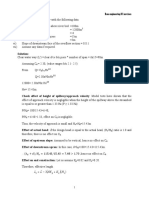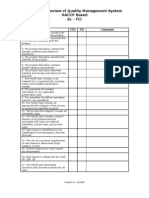Gravity Dam Design Example
Gravity Dam Design Example
Uploaded by
Mrmoa MohammedCopyright:
Available Formats
Gravity Dam Design Example
Gravity Dam Design Example
Uploaded by
Mrmoa MohammedOriginal Description:
Original Title
Copyright
Available Formats
Share this document
Did you find this document useful?
Is this content inappropriate?
Copyright:
Available Formats
Gravity Dam Design Example
Gravity Dam Design Example
Uploaded by
Mrmoa MohammedCopyright:
Available Formats
549
GRAVITY DAMS
Example 16.1 For the profile of a gravity dam shown in Fig. 16.8, compute principal
stresses for usual loading and vertical stresses for extreme loading at the heel and toe of the
base of the dam. Also determine factors of safety against overturning and sliding as well as
shear-friction factors of safety for usual loading and extreme loading (with drains inoperative)
conditions. Consider only downward earthquake acceleration for extreme loading condition.
Sediment is deposited to a height of 15 m in the reservoir. Other data are as follows:
Coefficient of shear friction, = 0.7 (usual loading)
= 0.85 (extreme loading)
Shear strength at concrete-rock contact, C = 150 104 N/m2
= 2.4 104 N/m3
Weight density of concrete
8
4
15
0.75
1
h = 96
Ww
0.15
30 1
0.3
Gallery
4.5
h = g
8
63.75
76.25
(a) Profile
4.8
g
38
Drains
inoperative
96
Drains operative
(b) Uplift pressure head diagram
Fig. 16.8 Profile and uplift pressure diagram for the gravity dam of Example 16.1
550
IRRIGATION AND WATER RESOURCES ENGINEERING
= 1 104 N/m3
Weight density of water
h = 0.1; v = 0.05
Solution:
Computation of Stresses:
(i) Usual loading combination (normal design reservoir elevation with appropriate dead
loads, uplift (with drains operative), silt, ice, tail-water, and thermal loads corresponding to usual temperature):
Resultant vertical force = W = sum of vertical forces at sl. nos. 1, 2 (i), 3 (i), and 4(ii)
of Table 16.1.
= (8584.50 + 394.88 2000.68 + 32.48) 104
= 7011.18 104 N
Resultant horizontal force = H = sum of horizontal forces at sl. nos. 2 (ii) and 4 (i) of
Table 16.1.
= ( 4567.50 153.00) 104
= 4720.50 104 N
Moment about toe of the dam at the base = M = sum of moments at sl. nos. 1,2, 3 (i),
and 4 of Table 16.1.
= [418302.75 + 27091.99 147334.50 96183.57 + 1662.88] 104
= 203539.55 104 Nm
Distance of the resultant from the toe, y =
M 203539.55 10 4
=
= 29.03 m
W
. 104
701118
Eccentricity, e = 38.125 29.03 = 9.10 m
(The resultant passes through the downstream of the centre of the base). Using Eqs.
(16.12) and (16.13)
yD =
. 10 4
.
W
6 910
6e
701118
=
1+
1+
b
b
76.25
76.25
LM
N
OP
Q
LM
N
OP
Q
= 157.79 104 N/m2
6 9.10
6e
7011.18 10 4
W
=
1
1
76.25
76.25
b
b
= 26.11 104 N/m2
yU =
LM
N
OP
Q
LM
N
Using Eq. (16.16), the major principal stress at the toe,
1D = yD sec2 D p tan2 D
1D = 157.79 104 1.5625 9 104 0.5625
= 239.66 104 N/m2
Using Eq. (16.21), shear stress at the toe, (yx)D = (yD p) tan D
(yx)D = (157.79 9) 104 0.75
= 111.59 104 N/m2
OP
Q
Dead load Wc
Water load
Vertical
Head-water Ww
Tail-water Ww
Horizontal
Head-water Wl
Tail-water Wl
Uplift force, U
Drains
operative
Drains
inoperative
2.
(i)
(a)
(b)
(ii)
(a)
(b)
3.
(i)
(ii)
1 0.5 87 76.25 1
1 9 76.25 1
1 38 4.8 1
1 58 4.8 0.5 1
1 29 71.45 0.5 1
1 9 71.45 1
1 0.5 96 96 1.0
1 0.5 9 9 1.0
1 66 4.5 1.0
1 0.5 30 4.5 1.0
1 0.5 9.0 6.75 1.0
1 30 4.5 0.5 2.4
1 100 8 2.4
1 85 63.75 0.5 2.4
(3)
(2)
(1)
1.
Force computations
(104 newtons)
Type of load
Sl.
No.
4003.13
3316.88
686.25
2000.68
182.40
139.20
1036.03
643.05
+ 394.88
+ 297.00
+ 67.50
+ 30.38
+ 8584.50
+ 162.00
+ 1920.00
+ 6502.50
(4)
Vertical forces
(downward + ve)
(104 newtons)
4567.50
4908.00
+ 40.50
(5)
Horizontal forces
(upstream + ve)
(104 newtons)
Magnitude of forces
50.83
38.13
73.85
74.65
47.63
35.73
32.00
3.00
76.25 2.25 = 74.00
76.25 1.50 = 74.75
(9 0.75)/3 = 2.25
73.25
67.75
42.50
(6)
Moment arm
(metres)
Table 16.1 Computation of forces and moments for unit length of dam section
13470.24
10391.28
49345.87
22976.18
(Contd.)...
194763.72
168597.01
26166.71
96183.57
147334.50
147456.00
+ 121.50
+ 27091.99
+21978.00
+5045.63
+ 68.36
+ 418302.75
+ 11866.50
+ 130080.00
+ 276356.25
(7)
Moment about
the toe (anticlockwise + ve)
(104 Nm)
GRAVITY DAMS
551
1Hydrodynamic
Tail-water1
(b)
(a)
Hydrodynamic
force
Head-water
(c1=cm for y=h)
(ii)
(i)
5.
(ii)
load
Earthquake
forces
Inertial
horizontal force
due to weight of
the dam
Load due to
sediment
deposit Ws
Excess horizontal pressure
Excess vertical
4.
(i)
(2)
(1)
491.19
2.76
488.43
50.00
28.33
10.00
76.25 4.5/3 = 74.75
15/3 = 5.00
(6)
force due to tail -water has been considered negative for the most critical condition.
At the base c = cm = 0.73
(for U = 0)
Vpe = 0.726 (0.73 0.1
1 96) 96
Mpe = 0.299 (0.73 0.1
1 96) (96)2
At the base c = cm = 0.47
(for D = tan1 (0.75))
Vpe = 0.726 (0.47 0.1 1
9) 9
Mpe = 0.299 (0.47 0.1
1 9) (9)2
858.45
192.00
650.25
1920.00 0.1
6502.50 0.1
153
(5)
16.20
32.48
(4)
162.00 0.1
1 0.5 15 2.25 1.925
1 0.5 15 15 1.36
(3)
19321.38
10.25
19311.13
28183.58
9600.00
18421.58
162.00
+ 1662.88
+ 2427.88
765.00
(7)
552
IRRIGATION AND WATER RESOURCES ENGINEERING
553
GRAVITY DAMS
Using Eq. (16.19), with pe = 0, the minor principal stress at the heel
1U = yU sec2 U p tan2 U
= 26.11 104 1.0225 96 104 0.0225
= 24.54 104 N/m2
Using Eq (16.22), shear stress at the heel, (yx)U = (yU p) tan U
(yx)U = (26.11 96.00) 104 0.15
= 10.48 104 N/m2
Further, major principal stress at the heel = p = 96 104 N/m2
and minor principal stress at the toe = p = 9.0 104 N/m2
Factor of safety for overturning =
=
Sliding factor
=
=
stabilising moment
overturning moment
(418302.75 + 27091.99 + 1662.88) 10 4
(147334.50 + 96183.57) 10 4
= 1.84
H
W
4720.55 10 4
701118
. 104
= 0.67
Shear-friction factor of safety (with drains operative),
Fs =
=
Cb 1 + W
H
150 104 76.25 1 + 0.7(701118
. 104 )
4720.50 104
= 3.46
(ii) Extreme loading combination (usual loading combination with drains inoperative
and the loading due to earthquake):
The inertial and hydrodynamic forces and corresponding moments due to horizontal
earthquake have been computed as shown in Table 16.1. The effect of vertical earthquake can
be included in stability computations by multiplying the forces by (1 + v) and (1 v) for
upward and downward accelerations, respectively. Since the computation of hydrodynamic
force involves the use of unit weight of water, the hydrodynamic force will also be modified by
vertical acceleration due to earthquake. Further, the effect of earthquake on uplift forces is
considered negligible. For reservoir full condition, the downward earthquake acceleration
results in more critical condition. Therefore, the following computations have been worked out
for the downward earthquake acceleration only.
Resultant vertical force with downward earthquake acceleration
= (8584.50 + 394.88 + 32.48) 104 0.95 2000.68 104
= 6560.59 104 N
Resultant horizontal force with downward earthquake acceleration
= (4567.50 + 153 + 858.45 + 491.19) 104
= 6070.14 104 N
554
IRRIGATION AND WATER RESOURCES ENGINEERING
Resultant moment about the toe with downward acceleration
= (418302.75 +27091.99 147334.50 + 1662.88 28183.58
19321.38) 104 0.95 194763.72 104
= 44843.53 104 Nm
Now,
y=
M 44843.53 10 4
= 6.835 m
=
W
6560.59 10 4
Eccentricity, e = 38.125 6.835 = 31.29 m
The resultant passes through the downstream side of the centre of the base. The value
of e is more than b/6 i.e., 12.71 m. Therefore, there would be tensile stresses around the heel of
the dam. The vertical stresses at the toe and heel with downward earthquake acceleration are,
yD =
W
6 31.29
6e
6560.59 10 4
=
1+
1+
b
b
76.25
76.25
FG
H
IJ
K
FG
H
IJ
K
= 297.89 104 N/m2
6 31.29
6e
6560.59 10 4
W
=
1
1
76.25
76.25
b
b
4
2
= 125.81 10 N/m
Factor of safety against overturning
and
Sliding factor
FG
H
yU =
IJ
K
FG
H
IJ
K
(418302.75 + 27091.99 + 1662.88) 10 4
= 1.15
(147334.50 + 194763.72 + 28183.58 + 19321.38) 10 4
H
W
=
=
( 4567.50 + 153 + 858.45 + 49119
. ) 10 4
6560.59 10 4
607014
.
= 0.925
6560.59
Shear-friction factor of safety, Fs =
=
=
Cb 1 + W
H
150 10 4 76.25 1 + 0.7 6560.59 104
607014
. 10 4
16029.91
= 2.64
607014
.
16.7. FOUNDATION TREATMENT
The foundation of a gravity dam should be firm and free of major faults which, if present, may
require costly foundation treatment. The entire loose overburden over the area of the foundation
to be occupied by the base of the dam should be removed. The dam itself must be based on the
firm material which can withstand the loads imposed by the dam, reservoir, and other
appurtenant structures. To consolidate the rock foundation and to make it an effective barrier
You might also like
- Gravity Dam Design Example PDFDocument6 pagesGravity Dam Design Example PDFMrmoa Mohammed80% (10)
- Ch10-Slope Stability ExamplesDocument19 pagesCh10-Slope Stability ExamplesRafi Sulaiman100% (3)
- Design of Vertical Drop Weir PG, Example, 2020Document9 pagesDesign of Vertical Drop Weir PG, Example, 2020zelalemniguse83% (6)
- Chapter 3 (CWR)Document37 pagesChapter 3 (CWR)Mūssā Mūhābā ZēĒthiopiāNo ratings yet
- CH - 2.3 Buttress Dam PDFDocument35 pagesCH - 2.3 Buttress Dam PDFHadush TadesseNo ratings yet
- Chapter 19Document37 pagesChapter 19rahul100% (4)
- CE5016 HydraulicsDocument43 pagesCE5016 HydraulicsKevin Huang100% (2)
- Examples (Sediment Transport) AUTUMN 2018Document6 pagesExamples (Sediment Transport) AUTUMN 2018orlaandoNo ratings yet
- Wrie Iii Prepared By: Yassin Y. Dam Engineering II ExercisesDocument6 pagesWrie Iii Prepared By: Yassin Y. Dam Engineering II ExercisesWalterHu100% (1)
- Exercises 2Document9 pagesExercises 2Nazakat Hussain100% (5)
- Ogee Spillway DesignDocument25 pagesOgee Spillway DesignEr Harsh Mahajan88% (32)
- Example On Design of Gravity DamDocument7 pagesExample On Design of Gravity DamKinfe Mehari100% (46)
- Lecture 1 - Prestressed ConcreteDocument15 pagesLecture 1 - Prestressed ConcreteHasini KadaruNo ratings yet
- The Shards - LondonDocument24 pagesThe Shards - LondonKruti Patel67% (3)
- Gravity DamDocument64 pagesGravity DamsubxaanalahNo ratings yet
- Worksheet - 143760187HS-II, TUTORIAL ON CH-5Document14 pagesWorksheet - 143760187HS-II, TUTORIAL ON CH-5A MusaverNo ratings yet
- Chapter 2 B 1 Arch ButressDocument19 pagesChapter 2 B 1 Arch ButressYasin Mohamed Bulqaaz100% (2)
- Anley Assignment1Document19 pagesAnley Assignment1banitessew82100% (1)
- Lecture Notes 03Document31 pagesLecture Notes 03kavinNo ratings yet
- Hydraulic Structure II AssignmentDocument6 pagesHydraulic Structure II Assignmentmasre1742100% (1)
- Chapter 3 Earth Dam 2020Document61 pagesChapter 3 Earth Dam 2020Ali ahmed100% (1)
- Model Question (Hydraulic Structures)Document5 pagesModel Question (Hydraulic Structures)Debanjan Banerjee71% (7)
- Phreatic Line PDFDocument21 pagesPhreatic Line PDFshubhamNo ratings yet
- Design of Concrete Arch DamsDocument28 pagesDesign of Concrete Arch DamsHabtamu Hailu100% (2)
- Assignment I. FinalDocument9 pagesAssignment I. FinalMaulid67% (6)
- Worksheet OneDocument4 pagesWorksheet OneRefisa JiruNo ratings yet
- Reservoir / Storage Routing Example 1: Storage CalculationDocument15 pagesReservoir / Storage Routing Example 1: Storage Calculationtesh100% (3)
- Gravity DamDocument28 pagesGravity DamChanako DaneNo ratings yet
- Module-III Concrete (Gravity) Dam EngineeringDocument43 pagesModule-III Concrete (Gravity) Dam EngineeringMadan Mohan ReddyNo ratings yet
- 7 Gravity DamsDocument35 pages7 Gravity Damskishing0905100% (1)
- Chapter-2: Design Principle of Concrete DamsDocument50 pagesChapter-2: Design Principle of Concrete DamsBura Ashx100% (2)
- Chapter No 4Document27 pagesChapter No 4Fahad Ahmed100% (3)
- Chap5 1 KennedyDocument15 pagesChap5 1 KennedyDarya MemonNo ratings yet
- Gravity DamsDocument46 pagesGravity Damscharchitchauhan0386% (37)
- Examples On Chapter 1 (1) #1Document17 pagesExamples On Chapter 1 (1) #1Boom OromiaNo ratings yet
- Lec-5 Unsteady Flow in Open Channels PDFDocument51 pagesLec-5 Unsteady Flow in Open Channels PDFshahid ali100% (2)
- Design Example Gravity DamDocument5 pagesDesign Example Gravity Damhanose100% (3)
- Blighs TheoryDocument5 pagesBlighs TheoryAnde Bhanu100% (1)
- Hydraulic Structures II ExamplesDocument4 pagesHydraulic Structures II ExamplesBona Hirko100% (2)
- Final Exam Dam Engineering 18-12-2020 PDFDocument11 pagesFinal Exam Dam Engineering 18-12-2020 PDFBaba ArslanNo ratings yet
- Assignment 2 Sediment - FinalDocument12 pagesAssignment 2 Sediment - Finalzelalemniguse100% (1)
- Assignment 12Document13 pagesAssignment 12yared sitotaw100% (1)
- Arbaminch University: Water Technology Institute Department of Hydraulic Engineering Open-Channel Hydraulics Make Up ExamDocument2 pagesArbaminch University: Water Technology Institute Department of Hydraulic Engineering Open-Channel Hydraulics Make Up ExamRefisa Jiru50% (2)
- Problems SpillwayDocument7 pagesProblems SpillwayPhacku MiaNo ratings yet
- Assignment On Concrete Dam Design and AnalysisDocument1 pageAssignment On Concrete Dam Design and AnalysisHabtamu Hailu100% (1)
- Assignment 1Document3 pagesAssignment 1Amanuel Enawgaw Amogehegn100% (2)
- River Engineering and Sediment Transport Solved ProbelemDocument6 pagesRiver Engineering and Sediment Transport Solved ProbelemMaulid100% (12)
- Module 1 Elements of Dam EngineeringDocument52 pagesModule 1 Elements of Dam EngineeringJun Urbano100% (1)
- Tut2004 G4HDocument3 pagesTut2004 G4HAbdiwali Y. Dhoof93% (14)
- Assignment Solution-3Document23 pagesAssignment Solution-3አድሜ ልስልሱNo ratings yet
- By Single Step Design Method PDFDocument10 pagesBy Single Step Design Method PDFZerihun Ibrahim83% (6)
- Name: - Maulid Adem Siyad ID: - 0211/12 Assignment - 2Document7 pagesName: - Maulid Adem Siyad ID: - 0211/12 Assignment - 2Maulid100% (1)
- Engg Hydrology Chapter - 3Document16 pagesEngg Hydrology Chapter - 3Abdu100% (2)
- Chap5-3 - Sediment TransportDocument19 pagesChap5-3 - Sediment TransportDarya MemonNo ratings yet
- Head and Cross RegulatorsDocument19 pagesHead and Cross RegulatorsEng Shakir H100% (1)
- Dam Lecture 17 - Determination of Phreatic Line in Earth DamDocument4 pagesDam Lecture 17 - Determination of Phreatic Line in Earth DamCarolineMwitaMoserega75% (8)
- τv= Vu bdDocument4 pagesτv= Vu bdDevendra_dreamerNo ratings yet
- Bab 2-AtapDocument38 pagesBab 2-AtapAbdul AzizNo ratings yet
- Case Ii1Document17 pagesCase Ii1123No ratings yet
- Transverse Shear Stresses in BeamsDocument6 pagesTransverse Shear Stresses in BeamsMijhael Anatholi Romero MamaniNo ratings yet
- Civil Cad Lab PDFDocument49 pagesCivil Cad Lab PDFArun RajNo ratings yet
- Job 3 SssDocument5 pagesJob 3 SssShah zaib UmerNo ratings yet
- HORSMAN USA CatalogueDocument650 pagesHORSMAN USA CatalogueRadu BabauNo ratings yet
- MST For IPS Panels OriDocument3 pagesMST For IPS Panels OriBabuNo ratings yet
- Seismic Performance of Buckling Restrained Braced Frames in A Chilean BuildingDocument12 pagesSeismic Performance of Buckling Restrained Braced Frames in A Chilean BuildingSebastian Contreras ContrerasNo ratings yet
- ISO 1302 DIN 4768 Comparison of Surface Roughness Values Stainless Steel T PDFDocument2 pagesISO 1302 DIN 4768 Comparison of Surface Roughness Values Stainless Steel T PDFWega Wahyu100% (3)
- Plastic Analysis AssignmentDocument6 pagesPlastic Analysis AssignmentLeo DoeNo ratings yet
- NCMA TEK 10-02B - Control Joints Empirical MethodDocument4 pagesNCMA TEK 10-02B - Control Joints Empirical MethodJeff HedmanNo ratings yet
- Assignment Number: Title: Reverse EngineeringDocument4 pagesAssignment Number: Title: Reverse EngineeringAditya GhugeNo ratings yet
- Marine Firestop SealantDocument4 pagesMarine Firestop SealantGilberto ZamudioNo ratings yet
- stm32-stm8 Industrial Embedded Software Solutions PDFDocument8 pagesstm32-stm8 Industrial Embedded Software Solutions PDFzbhp zNo ratings yet
- Code of Ethics PsmeDocument5 pagesCode of Ethics PsmeIan KasaiNo ratings yet
- Software Engineering: Dr.N.D.Kodikara, UCSCDocument36 pagesSoftware Engineering: Dr.N.D.Kodikara, UCSCragucmbNo ratings yet
- Expansion and Contraction Joints in Concrete PDFDocument5 pagesExpansion and Contraction Joints in Concrete PDFlamachapokha100% (2)
- Lycoming 1E4Document30 pagesLycoming 1E4ntNo ratings yet
- Software Development Life CycleDocument8 pagesSoftware Development Life Cycleapi-320326008No ratings yet
- Controllable Network Transformers: Deepak Divan and Jyoti SastryDocument6 pagesControllable Network Transformers: Deepak Divan and Jyoti SastryimdadamuNo ratings yet
- Document Review CheckListDocument3 pagesDocument Review CheckListTeggie WaqavonovonoNo ratings yet
- DO 178 B Brief NotesDocument18 pagesDO 178 B Brief NotesMani Shankar PrasadNo ratings yet
- 1920 Meng Electronic Engineering With Pathways 4436 4438 4439 4440 4441 4476 6043Document37 pages1920 Meng Electronic Engineering With Pathways 4436 4438 4439 4440 4441 4476 6043Mwaisa BangaNo ratings yet
- Steel ManualDocument114 pagesSteel ManualkysucoNo ratings yet
- Santosh ResumeDocument0 pagesSantosh ResumeengineeringwatchNo ratings yet
- Tentative Course List (July - Dec 2021)Document104 pagesTentative Course List (July - Dec 2021)Anil MamillapalliNo ratings yet
- Application Form - Institute of ValuersDocument5 pagesApplication Form - Institute of ValuersAnkur Shah100% (1)
- Syllabus Green ComputingDocument9 pagesSyllabus Green ComputingdhanishNo ratings yet
- SyllabusDocument2 pagesSyllabuselavarasansivaNo ratings yet
- Method Statement For Concreting WorksDocument10 pagesMethod Statement For Concreting WorksLy LysengNo ratings yet
- Sar UploadDocument202 pagesSar UploadzahidkharuriNo ratings yet
- dtl17813h PDFDocument15 pagesdtl17813h PDFhbookNo ratings yet
- Seismic Design Considerations For Pile Foundation EmgineeringDocument4 pagesSeismic Design Considerations For Pile Foundation EmgineeringtaosyeNo ratings yet

























































































